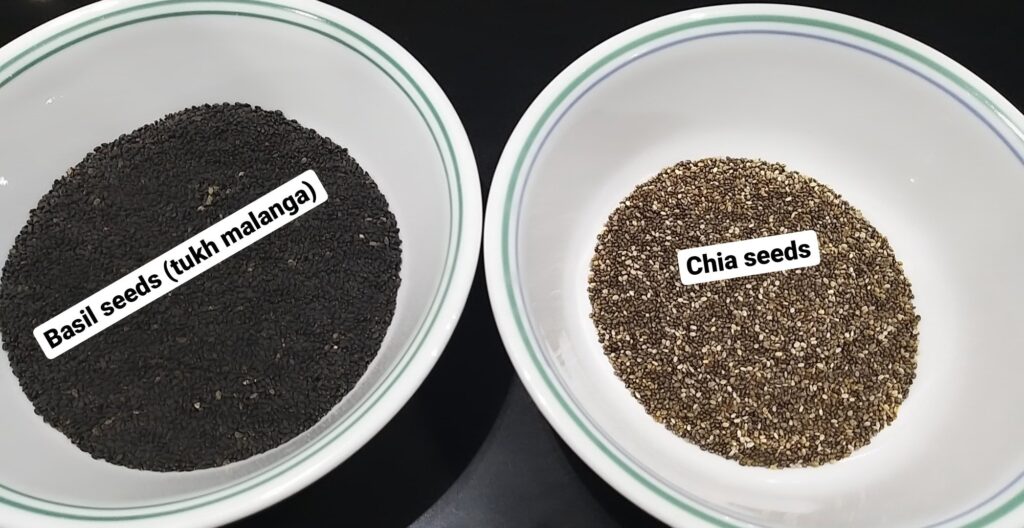Chia Seeds Vs Sabja Seeds: The Ultimate Superfood Showdown For Summer

Chia Seeds Vs Sabja Seeds: The Ultimate Superfood Showdown For Summer
While both offer various benefits, sabja seeds have a slight edge for summer due to their cooling properties and hydration.
8 June 2024
The summer sun can be brutal, making staying cool and hydrated a top priority. Certain superfoods can significantly impact how your body handles the heat. Two popular options are chia seeds and sabja seeds (also known as basil seeds). While similar in appearance, they have distinct characteristics and summer-specific advantages. Here’s a breakdown to help you choose which one to include in your summer diet.
Origins and Appearance
Chia seeds hail from the Salvia hispanica plant, native to Central and Southern Mexico and Guatemala. These small, oval seeds come in a mix of colours — black, white and grey. Sabja seeds, on the other hand, are harvested from the sweet basil plant (Ocimum basilicum) and are uniformly jet black and round in shape, primarily sourced from India and Southeast Asia.
Nutritional Content
Both chia and sabja seeds are nutrient-dense, but their profiles differ.
Chia Seeds:
ü Calories: 58 kcal per tablespoon
ü Protein: 2 g
ü Carbohydrates: 5 g
ü Fibre: 4 g
ü Fat: 3.8 g (including omega-3 fatty acids)
ü Minerals: Calcium, Iron, Magnesium, Phosphorus
ü Chia seeds are also rich in antioxidants, vitamins and other minerals.
Sabja Seeds:
ü Calories: 57 kcal per tablespoon (13 grams)
ü Protein: 2 g
ü Carbohydrates: 7 g
ü Fat: 2.5 g (including omega-3 fatty acids)
ü Minerals: Calcium, Iron, Magnesium
Sabja seeds are packed with polyphenols and flavonoids, boosting their antioxidant properties.
Health Benefits
Chia Seeds
· Hydration: They absorb up to 12 times their weight in water, aiding hydration.
· Digestion: High fibre content supports gut health and weight management.
· Heart Health: Omega-3 fatty acids reduce inflammation and support heart health.
· Blood Sugar Control: Chia seeds help stabilise blood sugar levels for sustained energy.
Sabja Seeds
· Cooling Effect: Excellent for reducing body heat, making them ideal for summer.
· Digestion: Helps relieve constipation and acidity.
· Diabetes Management: Beneficial for diabetic patients by lowering blood sugar levels.
· Weight Management: Promotes a feeling of fullness, reducing appetite and aiding in weight loss.
· Hydration: Like chia seeds, they absorb water and help keep the body hydrated.
How to Consume Them
Chia Seeds:
Eaten raw, added to drinks, or soaked for a gel-like consistency. Blended into smoothies or made into chia pudding with milk. Added to bread, muffins, or used as an egg substitute in vegan recipes.
Sabja Seeds:
Typically soaked before consumption. Added to lemonades, juices, and smoothies for a refreshing drink. Used in traditional desserts like falooda. Sprinkled on top of salads or curd for added texture.
Which is Better for Summer?
While both offer various benefits, sabja seeds have a slight edge for summer due to their cooling properties and hydration. Their ability to lower body temperature and provide quick hydration makes them a preferred choice during hot months.
Chia seeds, however, are also highly beneficial and versatile, offering extensive nutritional benefits and ease of use. Including both in your diet can provide a balanced variety of nutrients and health advantages.
To Conclude:
Both chia and sabja seeds can play a crucial role in maintaining hydration and overall health during the summer. Sabja seeds might be the go-to choice for beating the heat, while chia seeds offer a robust array of nutrients year-round. Consider incorporating both into your diet to enjoy the unique benefits each superfood has to offer.









